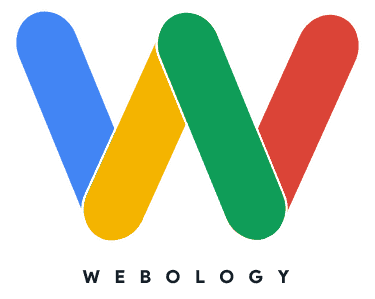Whether you’re new to SEO or not so new, this blog post will help you get on the right track.
We’ll be discussing everything about SEO, how it works, and what you need to do to increase your page’s ranking.
So sit back, relax, and learn with us!
Quickly Learn What Works in Modern SEO
Use this table of contents to easily jump to the section in this article you want to learn more about.
How Does SEO Work?
Search engine optimization (SEO) is all about getting your website to rank higher in search engines like Google, Yahoo! and Bing.
It’s an important part of any online marketing strategy because it can help you attract new customers who are specifically searching for the products or services you offer.
But how does SEO work?
What separates a great SEO campaign from a poor one?
And what should you do if your site isn’t ranking as high as you hope it should?

Search Engine Optimization Basics – What is SEO?
Let’s start by defining what SEO exactly is. SEO stands for Search Engine Optimization.
This is the process of acquiring unpaid traffic to a webpage —often referred to as “natural”, “organic”, or “earned” results. SEO’s goal is to improve a website’s position in the search results pages because the higher the page’s ranking is, the more people will see it. More visibility means more traffic and more potential customers.
Sounds great, right?
In this digital era, SEO is considered to be one of the most essential parts of a successful online marketing strategy.
Just don’t expect instant results…SEO requires a lot of work and it takes time before your efforts are rewarded by Google and other search engines.
What does SEO involve?
There are many factors that go into a successful SEO campaign, including an optimized website or blog, backlinks from high-quality sites, content marketing to drive traffic and generate leads, social media promotion, and more.
These components all work together to help you attract new customers and drive sales.
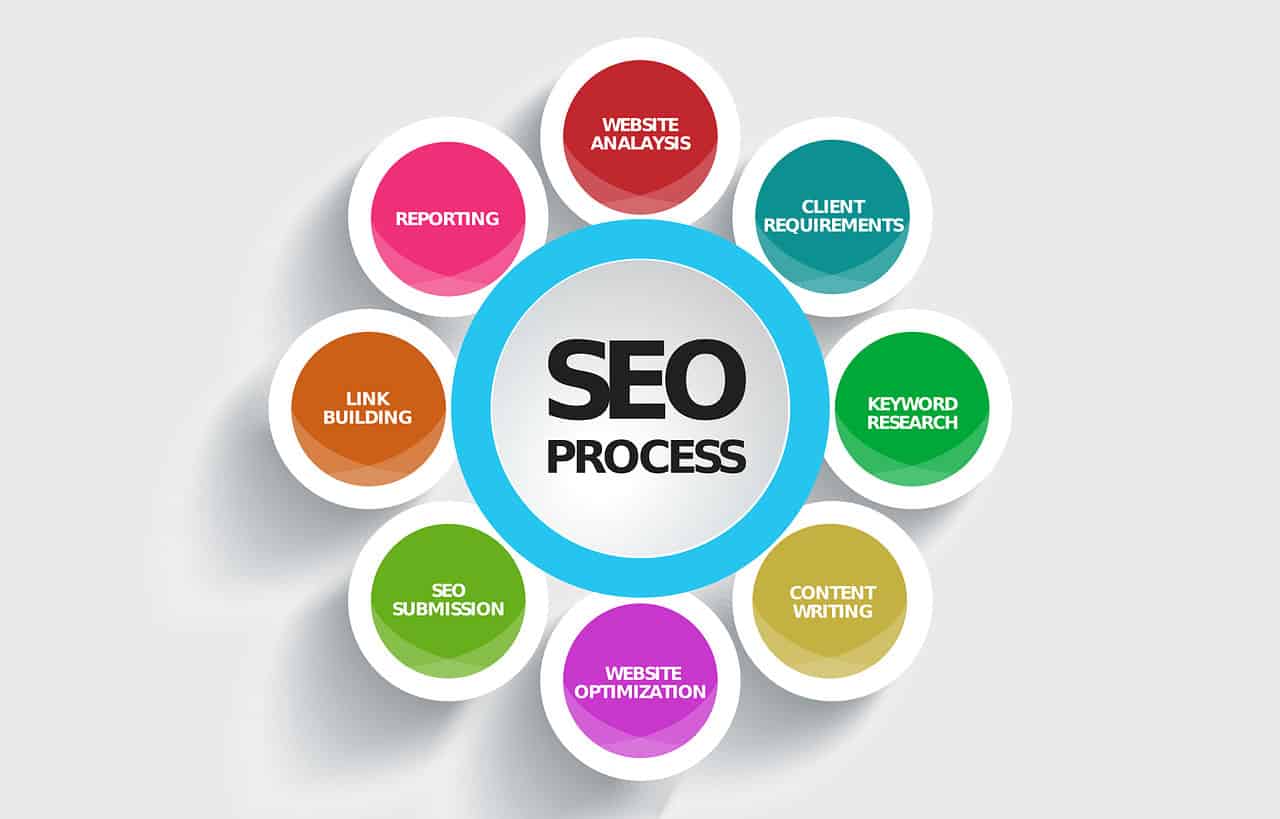
In our opinion the main thing to remember is that SEO involves constant activity.
Building up your website over time to be better and better is what Google’s looking for.
Of course, if you don’t have the time or resources yet to fully invest in SEO, there’s always the option to simply pay Google for page #1 placement.
Paid Advertising vs. Organic Search Marketing
Before we go into the nitty-gritty of how SEO works, let’s first identify how organic search is different from paid search. We’ve mentioned earlier that SEO helps a page to acquire “organic” traffic.
But what does this really mean?
To help you get a better understanding of this area, let us give you a detailed comparison regarding paid and organic searches.
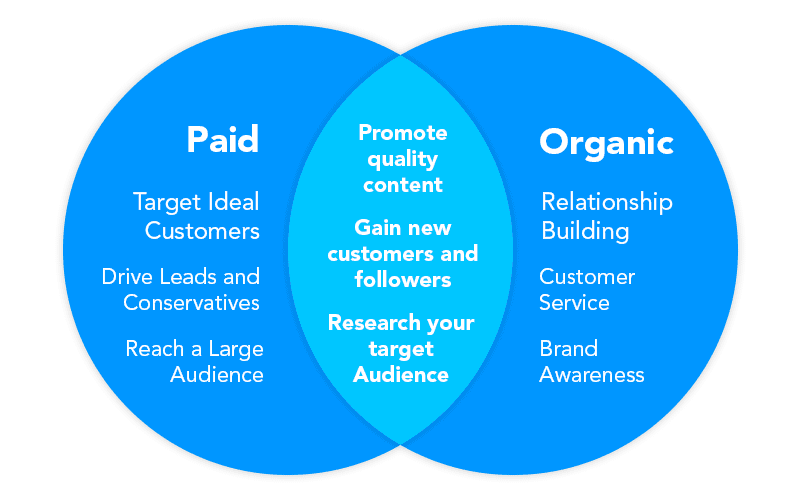
-
Position
– Paid searches appear at the top of the search results page above the organic results.
-
Results
– Paid ad campaigns give instant results in as fast as a few minutes while organic results take a bit more time, from weeks to even years.
-
Cost
– Well, this is the most obvious piece as you need to pay for the results. Search engines will charge you for every click your ad gets. This is known as pay-per-click (PPC). Technically, you are buying traffic from Google as you instruct them to show your page to people searching for specific keywords. Organic searches, on the other hand, are free but they do require a different type of investment. Most commonly time and effort.
-
Return
– ROI is easier to measure when it comes to paid search since Google will provide you with more detailed keyword data over what you can get from Google Search Console for organic searches.
-
Share of traffic
– When it comes to traffic share though, organic search is the king as only 20 to 30% of searchers click on paid searches. While 70 to 80% go to organic results. This is why it’s very important to improve your page’s organic ranking, although running some paid ads will help you get immediate traffic in a pinch.
Three Key Components of a Successful SEO Campaign
For digital marketers, it’s crucial that you know how to get your brand, website, or company visible to as many people as possible.
The good thing is, with the right SEO strategy, you have a very high chance to achieve this.
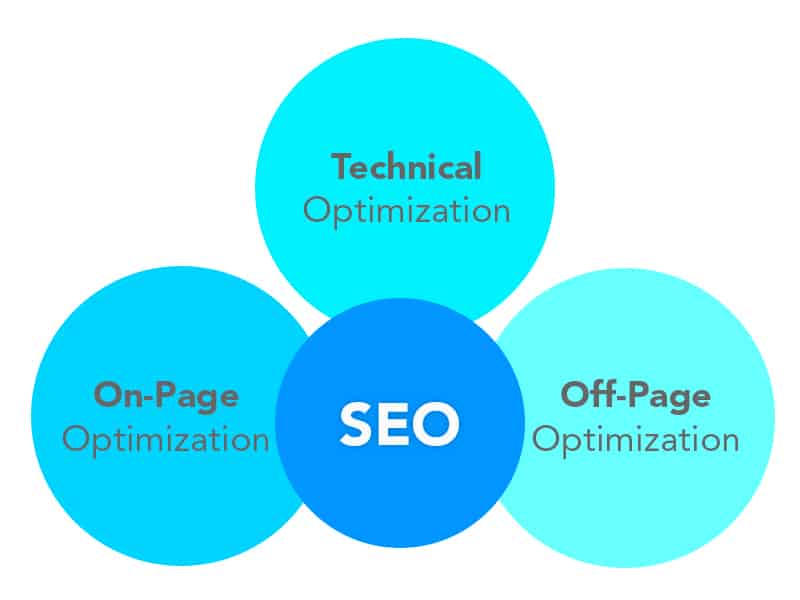
SEO is an ever-changing game. Google, Bing and other search engines release updates on a weekly or monthly basis. Although those small changes are very common, the fundamental principles of SEO do not change.
We may divide SEO into three fundamental pillars or components to pay attention to:
Technical Optimization – This refers to the optimization of your website’s HTML code. The technical elements include things like page load speeds, XML sitemaps, URL structures, and many others which cannot be changed directly by you as an SEO specialist, but instead require help from a developer. This is because many technical aspects must be done with caution in order to avoid any negative impact on your website.
On-Page Optimization – This component is all about crafting an outstanding content plan. The amount of time you spend on this stage will determine your overall success, so it’s important to put in the effort required for keyword research and topic selection. Remember, in SEO, quality and reader engagement is the key. Unlike technical optimization, on-page optimization is very much manageable by you as a digital marketer without having to ask for help from others.
Off-Page Optimization – This part can be summarized as increasing the quantity and quality of backlinks. Google looks at links from other pages on the internet that point to yours like votes in a popularity contest. The more sites that link to yours, the higher the reward from Google. Off-Page SEO can also be divided into two categories which are link earning and link building. Either of these will help build the site’s reputation, but it’s important to remember that the more difficult to acquire links usually have the biggest impact on your rankings.
How do Search Engines Work?
Now that we’ve answered your first question, how does SEO work, it’s important to take a step back and also learn how the search engines themselves work.
Search engines are used by people when they are looking for services, products, or when they need information on the internet.
The most popular example is Google, but there are many more competing alternatives out there hoping for wider use.
These search engines all compete for traffic just like any other online business, and the primary way one search engine attracts more users than their competitors is to provide more relevant content for the person performing the search. That’s the business model in a nutshell, but you’re probably wondering just how Google manages to always have the best content at this point, right?
In my opinion, the most important factor to Google’s continued success is the massive amounts of money they’re able to reinvest into their product. Google’s constantly testing and improving the algorithms that determine what content shows up in their search engine results page, or SERP for short.
How Does a Search Engine Rank Content?
Search engines make use of advanced algorithms to sort and rank web pages into a SERP.
These are computer programs that find clues to provide the users with the most exact answers to their queries.
Search engines all rely on these programs to find what pages to show searchers with the goal of providing the best results possible.
That way, you’ll keep coming back to use their service instead of switching over to a competitor like Bing or DuckDuckGo.
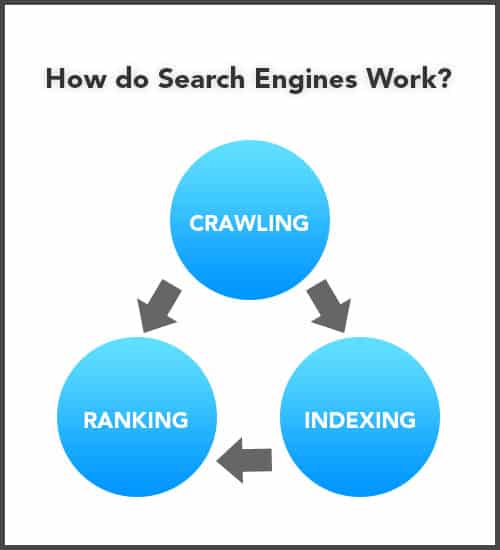
There are three steps that happen in the backend of search engines which are the following:
Step 1 – Crawling. This process allows the search engines to discover new pages on your site and check if there have been any updates on pages that were previously visited in the last crawl. If you don’t want Google or other crawlers to see a page or post, you have the option to use your websites robots txt file. The robots txt file resides on your web server and it’s the first thing crawlers will look at.
Step 2 – Indexing. This process is where the search engine decides whether it will use the crawled content or not. If the search engine finds the content to be worthy or relevant to the search, it will be indexed where it is filed and stored in a database to be retrieved later. The indexed content or pages are then used during the final stage. Pages may not be easily indexed if:
- It is duplicate content.
- The content is low-value or spammy.
- The page does not contain inbound links.
You also have the option to tell Google you don’t want a page to appear in their organic search results by adding a noindex HTML tag on your page.
Step 3 – Ranking. These algorithms rank each page based on its value depending on how relevant or useful a webpage is for a specific search engine results query, which is the final step. There are many factors that search engines use to sort and rank content but they all fit neatly under the three components of SEO we mentioned earlier – on-page optimization, off-page optimization, and technical SEO.
Below are the top signals that search engines use during the ranking stage:
These are segmented into the three components I just mentioned to show you the most important areas to focus on for each one.
-
On-Page: Keywords in the title tag, URL, and primary heading or H1 tag.
-
Off-Page: Links pointing to a page from other sites are very important.
-
Technical: Speed and how fast the page loads on a mobile device matters.
Related Post: 8 Tips to Improve Your Meta Titles for [EASY] SEO Wins
Now that you understand the three main components to any successful SEO campaign, let’s continue with an example from each of them. We’ll start with my personal favorite, on-page SEO.
Why do I like on-page SEO so much?
The first reason is that on-page SEO is something you have complete control over. I don’t know how many links I will earn from an outreach campaign, but I do know the exact steps to improve a page on my own site.
My second reason is costs…no matter how you do it, any form of link-building will cost money.
Pro Tip: Correlational On-Page SEO Works Great Right Now…
What is it Exactly?
To get the best results out of the links we acquire for clients, my team always puts in the time to get the on-page metrics right first. We use correlational tools to figure out what’s in our competition’s HTML code and then reverse engineer it to build a page that will rank well based on known signals.
That’s what correlational on-page SEO is. We have a list of known ranking factors that have been proven through single variable testing processes that rely on a scientific method. Using that list, we’re able to compare our pages against top-ranked competitors and know what it takes to beat them.
Here’s a quick example:
As I’m writing this post you’re reading right now, I’m also checking and constantly improving the on-page SEO metrics.
One fairly important signal is the total number of paragraph or <p> tags in your code. If your average is way off from the competition, you might not rank as well.
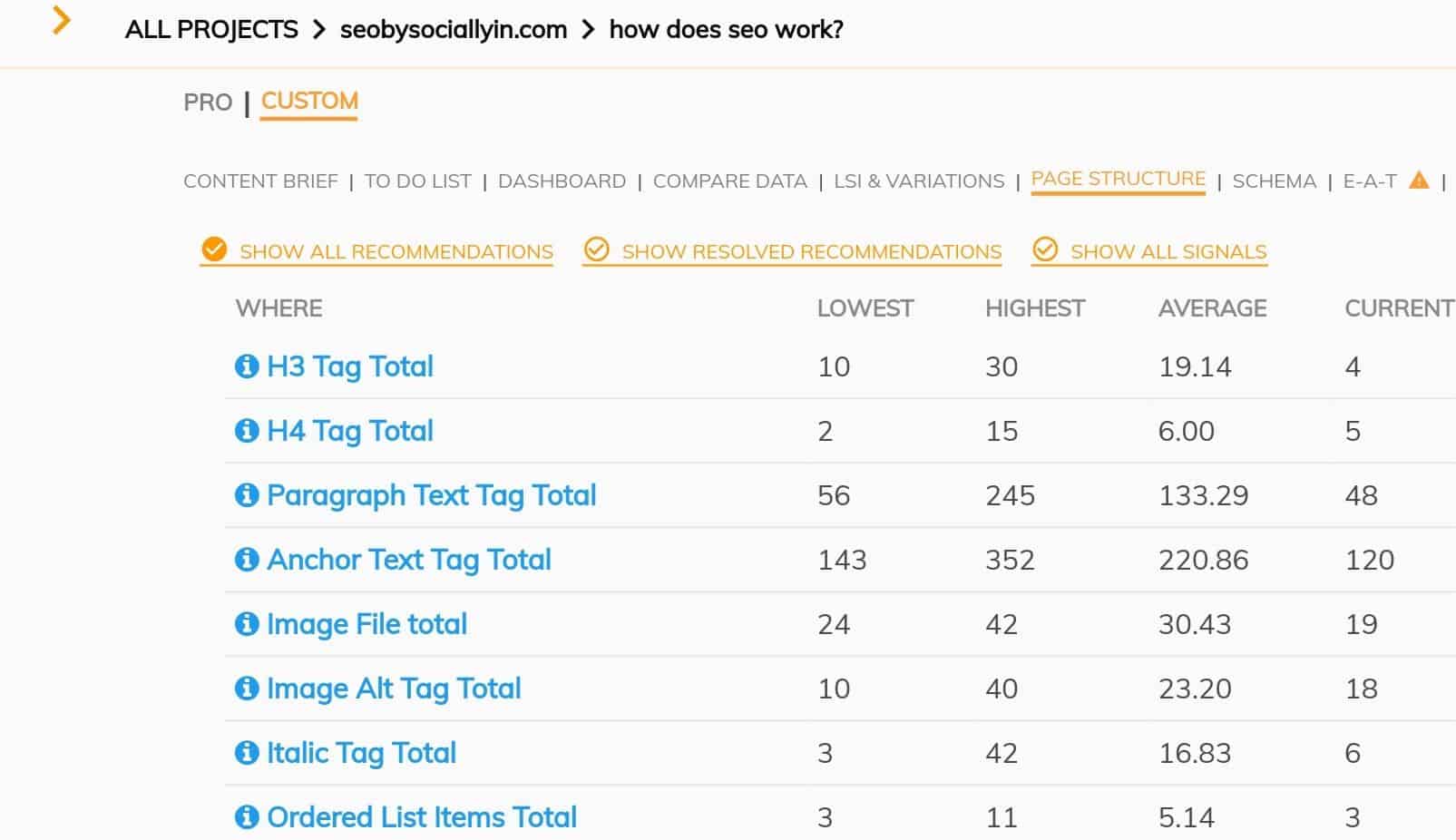
At the time of writing, a few signals stand out to me. For one, I need waaayyyy more links in this content! 120 to be exact. That will take a lot of work, but I can fix the <p> tags easily. By default, WordPress is using a different code to add spacing around my content. See for yourself:

That was an easy fix with a little find and replace magic. Now let’s look at technical SEO and specifically, speed.

This post loads in about 2.3 seconds, which is not bad considering all the images I’ve added so far. Aside from javascript, image files are usually the largest file sizes on a page and they tend to slow things down a lot.
Here’s a few rules for adding images to your website so that you don’t have any issues:
- Never use images directly from your phone or camera. Scale them down.
- Try to stick to newer file formats wherever possible.
- Use an image compression tool with a lossy algorithm.
Image file size optimization is a great example of technical SEO. Much like on-page, it’s all about these little details and having a checklist is critical to keeping your website in top shape.
Next Up: Off-Site SEO
Now that we have the basics out of the way, let’s travel off-site and look at a simple link-building strategy we can use for this page. Since we have a local office in Birmingham, I have a Google Business Profile set up for my division.
Google loves it when you use their products, so why not share this post there like we always do?
Here’s a recent post I shared to my profile to earn a link directly from Google:
I zoomed way in to make the links more visible. Here’s our Business.Site page if you want to check it out yourself.
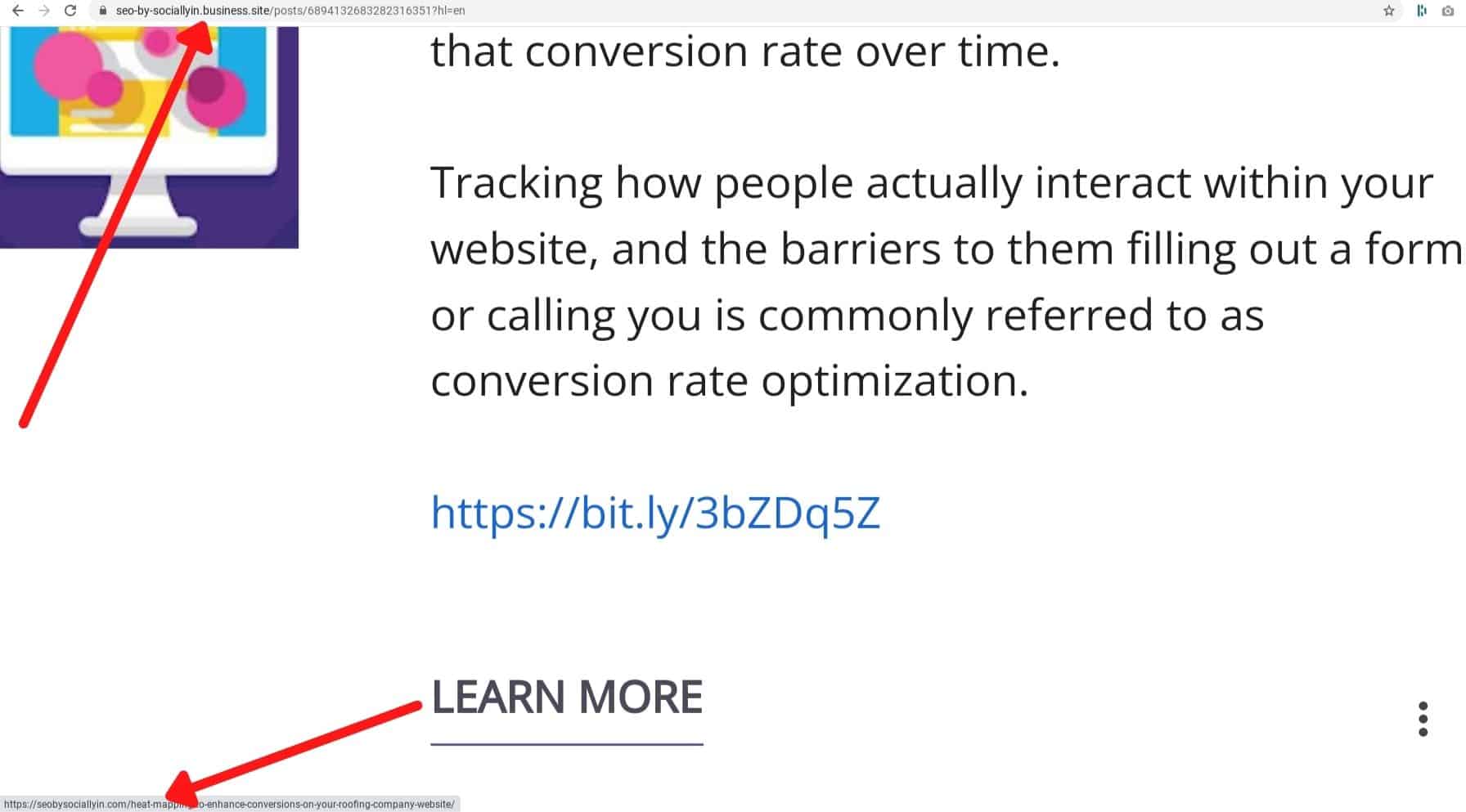
When you set up a Google Business profile, they give you a free subdomain on the www.business.site address, which is a Google owned URL. I set mine up so that whenever I post to my Google Business Profile, I’m also getting another set of links from here as well. While these aren’t the most powerful links, they’re easy to get and they help my local SEO strategy nicely.
Remember These Examples are Just 3 Out of the Hundreds of SEO Tasks
There’s so many other steps to take in each of the three main components of SEO that you really have to spend a lot of time building out complete processes your team can follow. If you want to stay ahead of the competition, that’s what it takes in all but the least competitive search results.
What Can You Do to Measure Results in an SEO Campaign?
The easiest way to measure results in an SEO campaign is going to be through Google Search Console. It’s a free Google product that has some of the most trusted data on organic search volume. It’s also full of useful information on your website’s core SEO metrics as seen by Google like indexing, backlinks, web core vitals, and more.

Now You Know the Basics of SEO!
SEO is a great way to increase the traffic of your website on both Google and other search engines. You can get a very good return on investment for the long term if you have an outstanding content plan, do some technical optimization work with care, and keep up-to-date with link-building strategies, which will improve your site’s reputation.
Most importantly, testing and measuring results is the key. SEO may sound complicated and difficult since it requires tons of data analysis, which will require a lot of time and effort to master. It’s not that tough to pull off though if you stay focused on the big picture and get all the basics right. We assure you the time and effort you will invest in it is definitely worth it!
Need help with your SEO? Be sure to sign up for our free audit service and learn the next steps to unlocking massive traffic from Google.
If you want to take your search engine rankings to the next level and don’t have time, our agency is here to help. From local SEO to eCommerce solutions, we have the experience to guide your strategy in the right direction so you get the Google ranking you deserve. Call Webology today and ask about our professional SEO services – (205) 671-2790.
